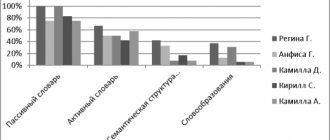Automation of the sound [P] in combinations with consonant sounds
I present to the readers of the LogopedRunet website a selection of materials for automating the sound [R] in combinations with consonant sounds.
The sound [P] in syllables with a confluence of consonants:
Stra-stro-stru-stra Zdra-zdro-zdra-zdra Bra - bra - bro - bru
Rba - rby - rbo - rbu Pra - pry - about - pr Kra - kry - kro - kru
Rka - rky - rko - rku Gra - gry - gro - gru Hra - hry - hro - hru
Vra - vra - vro - lying Fra - fra - fro - fru Mra - mry - mro - mru
Nra - nry - nro - nru Shra - shry - shro - shru Rzha - rye - rzho - rzhu
Zra - zry - zro - zru
The sound [P] in words with a combination of consonants:
* Fear, ostrich, guard, strange, country, page, line, construction, strict, build, shavings, jet, string, sharp, fast, chandelier, fast, fires, minister, breakfast, threesome, fine, drill, monster, tool , centers, hello, health resort, suddenly, spacesuit, coriander, Ichthyander.
* Brother, take, bracelet, scold, pick up, meeting, cobra, zebra, mop, eyebrows, brooch, throw, throw, wander, tramp, throw, kindness, wade, throw, kindness, splashes, splash, cheese, kicks, beavers , cliff, kind, lingonberry, harness, hoop.
* True, holiday, laundress, rule, help, right, cork, wire, simple, against, sheet, sell, products, cold, cold, nasty, walk, curdled milk, seller, opposite, pond, twig, spring, elastic, jump , jumper, jump.
* France, Frosya, fruit, fruit, fruity.
* Doctor, enemy, enmity, like, liar, hand over, manually.
* Edge, tap, crab, paint, red, nettle, beauty, beautiful, blood, mole, crumbs, rabbit, except, edge, bed, sneakers, microbe, acrobat, dill, pattern, circle, mug, large, lace, cereal , steep, around, twist, circle, around, Crimea, rat, roof, lid, gooseberry, closed, open, wet, open, close.
* Rake, diploma, rook, hail, thermometer, robber, border, grenade, game, play, reward, photograph, grapes, photographer, thunder, rumble, menacing, loud, thunderstorms, thunderstorm, rumble, load, milk mushroom, group, pear , sadness, sad, rude, truck, load, load, gnaw, rodent, games, tigers.
* Temple, snore, snore, store, guard, guard, guard, preserve, crunch, fragile, crystal, crunchy, crisp, lame, limp, terry.
* Immediately, fight, battle, deadline, urgent, cut down, break down.
* Gloom, marble, gloomy, like; scar; zrazy.
Words with the sound [R]:
Patter, orchestra, size, marble, porcelain, mortar, airfield, transport, tractor, sidewalk, conversation, apartment, brave, temperature, agile, electrician, thermometer, constructor, farmer, airport, route, floor lamp, resort, curtains, space, ice hole, literature, program, paint, test tube, check, deftly, parting, professor, rubbing, fair, gap, procedure, viewing, widespread
Repeat phrases and sentences:
* Steep mountain, steep cliff, wet grass, brave soldier, red pomegranate, evenly parted, sharp turn, elastic spring, round core, open transom, wingspan, lace pattern, passage yard, brave tiger, noisy meeting, ripe lingonberries, salted feta cheese, native land, huge park, large grapes, slate roof, drum roll, foreign stamp, luggage storage, black pupils, canned tomatoes, pronounce tongue twisters, photograph a friend, return from the airfield, march with an orchestra.
* The photographer takes photographs. Ira opened the window. Chickens are fed cereals. The seller sells fruit. Raya bought a brooch. The drummer drums loudly. Variegated asters decorate the garden. Tamara has a red pencil. Raya jumps over the rope. The rook's wing is damaged. Friendly beavers are building a dam. Steamers are unloading at the port. The path ends at the ravine. Various fruits are sold at the market. Roma collected two buckets of saffron milk caps. In the morning the fishermen went to the lake. A swift stream runs down the mountain. A gray rabbit gnaws a red carrot. Canned crabs for sale. The mole spoils the roots of plants. The road to the pond goes past a cedar grove. Prokhor jumps into a pond from a steep cliff. A huge old oak tree grew on the edge of a steep cliff. In the evening, along a steep path, the athletes reached the top of the mountain. You can’t even take a fish out of a pond without difficulty. The steep hill has wormholes. All beavers are kind to their beavers.
Distribution of consonant phonemes
Philological sciences / 1. Methods of teaching language and literature
Doctor of Philology Raimbekova M.A.
Kazakh National Pedagogical University named after Abay. Kazakhstan
The ability to speak correctly, without an accent, is an important and necessary requirement when learning the Russian language. Incorrect pronunciation of a particular sound or their combination leads to misunderstanding between interlocutors, since the meaning of a word, phrase, or phrase may be distorted.
A significant part of researchers believe that one of the main reasons for deviations in the speech of bilinguals is interlingual interference, that is, the transfer of features of the native language to the target, non-native language. Indeed, Kazakh students, pronouncing unfamiliar sounds, words, phrases, reproduce them as they hear them. A particular difficulty for them is pronouncing a combination of consonants in the initial position of a Russian word. The reason is that the combination of several consonants in the initial position of a word is a complex phenomenon for a person speaking Kazakh.
In Russian, a cluster of several consonants occurs in any position of a word, and can consist of 2-3-4 components. At the same time, there are groups of both convenient and inconvenient consonantal compounds in pronunciation, which are realized at the beginning, in the middle and at the end of the word. However, most often they are used at the beginning of a word. Among them, the most easily pronounceable combinations include compounds like: ST -,
SR -, TR -.
(
S
-spirant
, T
-stop,
R-
sonorant). [4. p.119].
In Turkic languages, according to scientists, the combination of consonant phonemes in the initial position of a word is not a very convenient phenomenon and, most likely, impossible. About this Trofimov M.I. [With. 63] writes in Turkic languages: “...words with the initial group SS -
(
consonant + consonant) when borrowed, they acquire an initial V -
(vowel) - or receive an epenthetic (insert) -
V - (C V C),
i.e., the vowel appears either at the beginning of the word or between the initial consonants, for example
:
the Russian word stol in the Tatar and Bashkir languages it is pronounced as өstәл, in the Khakass word pillar is pronounced ystolba, the bracket is yskop, scaffold-pylah; tarpaulin - perezen; in the Kyrgyz language the words tractor are pronounced as tyraktyr, etc.
In the colloquial speech of Turkic languages, according to M.I. Trofimov [p.119], SSS
as a result of the loss of the usually narrow vowels
і
and
и
, which leads to the coexistence of such forms as in the Tatar and Bashkir languages - Biznіn -b¢znіn (our), etc.
TST /
R – CSC
arise , for example: the Uzbek word k ishloq
(kishlak) sounds like [k ¢shlok]. In addition, he notes that vowel reduction can sometimes lead to the formation of words without vowel phonemes such as SS,
for example: in the Tatar and Bashkir languages: [t¢l]
(language), [b'z] (we), [k¢sh¢] (person) or in the Azerbaijani language borrowings from the Russian language sound like: director, psateli, kratka, blavka, dash - tre, accountant-phalter name Riza sounds like Rza, etc.
A.M. Shcherbak notes that in the colloquial speech of Turkic languages, at the absolute beginning of a word, as a result of the reduction of narrow vowels, confluences of consonants are observed. “The size of the reduction of narrow vowels in a polysyllabic word increases sharply, especially in the languages of the Kipchak group... compare the Tatar word turam - [tram] - I stand, bulam - [bl¢әm] - I know." [p.63]
It is believed that in the Kazakh language a combination of consonants does not occur in the initial position of a word. Indeed, when pronouncing Russian words with consonantal compounds at the beginning of the word, Kazakh-speaking students appear either the prosthetic cabinet - ishkap, table - [үst¢өl], or epenthesis, for example: the word t r i k o is pronounced as [t¢іriko] ,
trust as [t¢ires], they pronounce the word look as [vy
z
g¢la t], and the phrase k d o u m is pronounced - k y d o m u, etc.
Kazakh vocalism is characterized by the presence of wide ( a,ә, o, ө, e
) and narrow (
ы, і, ү, ұ
) vowels. Moreover, narrow vowels, by their acoustic and physiological nature, are almost 2-2.5 times shorter than wide vowels.
“... narrow vowels... are characterized by instability and the ability to be reduced... Due to their brevity in unstressed syllables, they are reduced to the point of complete disappearance” [1. p.7].
This article presents data obtained through an instrumental study of words in the enlaut of which narrow vowels are found. It has been noticed that very often these vowels are dropped when speaking. For example, names like Is kender, Ystambek,
Yskak, Ysrail, Ismet,
etc. and surnames derived from them, which have an initial narrow vowel, are most often pronounced without initial vowels.
And in modern Russian orthography, the above surnames are already transmitted without an initial vowel, for example, surnames like: Tlendiev from
Tilendiev
, Smanov
from Ysmanov
, Shbyntaev
from Shybyntaev, etc. In colloquial speech, these and the above names and surnames are often pronounced without a vowel, but in orthography In the Kazakh language, these vowels are preserved.
The results of an experimental phonetic study of words, phrases and phrases showed that with complete reduction of a vowel located at the beginning of a word or between the initial consonants, combinations of two, sometimes three, consonants are formed. For example, the word ysty қ
pronounced
- st yk
(hot
), kisen
- xen (puts
), k itap
- ktap (book),
uydin shyrgy
-
shrgy (light in the house) , kesip - pishken - kesip - pshken (kroil ), b і distributed ber і -
brazdan ber
i (
recently
), at ka kisen salu - at ka ksen salu
((to entangle the horse’s legs), etc.
So, based on the analysis of the experimental study, the following conclusions can be drawn that most often narrow vowels are reduced before or between stops and sonants T R -
, before sonorous
P
and
M,
also in the
TS- position,
i.e.
in the vicinity of stops and spirants, i.e. between С
and
Ш
and in the group
SR -, ST -
(spirant + sonorant and spirant + stop. This conclusion is confirmed by Turkologists. According to scientists, the loss of vowels occurs more easily in the vicinity of long sonants or spirants. In addition, they believe that, along with the factor of vowel reduction, there is a factor of absorption (absorption) of a vowel by a long consonant [3.p. 10]. In addition, groups of consonantal compounds of consonants in the initial position of a Kazakh word like:
T R -. SR -, S T-
are also characteristic for many languages of the world. And these
“
typical
”
initial groups with the structure
T R -. SR -, S T-
“... are most consistent with the pronunciation capabilities of a person” [4.p. 63].
Thus, for the orthoepy of the Kazakh language, the element of a confluence of consonants in the initial position of a word is a possible phenomenon, therefore the results of the study can serve as a basis for practicing the pronunciation of a confluence of consonant phonemes in the initial position of a Russian word.
Literature
1. Kaliev B.K. Reduction of narrow vowel sounds in the Kazakh and Karakalpak languages. A., 1967
2. Raimbekova M.A. Long vowels in the Kazakh language. A. 1968
3. Trofimov M.I. Phonetic processes in the modern Uyghur language, A. 1978.
4. Shevaroshkin L.M. Sound chains in the languages of the world. M., 1969
5. Shcherbak AM Comparative phonetics of Turkic languages. L., 1970
Literary editing. The problem of cacophony. Basic phonetic errors and shortcomings
What is written should be readable and pronounceable. Thus, euphony presupposes the most perfect combination of sounds for speakers of a given language. Euphony must be correlated with the phonetic features of the language. The division of sounds into euphonious and dissonant is assessed as subjective. Anything that is unusual for a particular language is classified as cacophony. – it’s unusual to pronounce 3 or more consonants in a row.
The most natural sound is achieved by alternating acc. and ch. sounds and minor use of consonant combinations. A combination of 4 or more consonants that may appear at the junction of words violates the euphony. It is unusual for RY not only to emphasize consonants, but also vowels, although there are only 6 vowels. To create euphony, the sequence of sounds is also important. When establishing compatibility laws, 2 cases are possible:
- phonetically impossible combination
- the combination is possible, but only in one or two variants of the word.
In RY, the combination of consonants, constructed according to the law of ascending sonority, predominates. Atypical would be: pretzel, ice cream. The more vowel sounds, the more harmonious the speech - this is not entirely true, since the combination of several vowels distorts Russian speech. This combination is called gaping. Radio audio
External confluence is a confluence of vowels when combining words. At Tanya's and Inna's.
Euphony is influenced by the alternation of stressed and unstressed syllables. Speech is considered euphonious if polysyllabic words alternate with short ones. Eliminating cacophony:
— instead of complex abbreviated dissonant names, it is preferable to use full ones.
— When there is a cluster of dissonant participles with the suffixes вш, уш, ььш, аш, яш
- With the incorrect use of prepositions that have stylistic variants about all this - about all this
— When using borrowed words with unusual phonics, replace them with synonyms.
Eliminating errors in the sound organization of speech is the last stage in editing. Phonostylistic errors are less noticeable than spelling errors, so you need to read the text carefully and be sure to pronounce it.
Phonetic errors:
Angophrasia is a break in speech by vowels or consonants: mmm.....uh...
Sound associations associated with taboo space.
Gaping is a dissonant combination of vowels within a word (internal) or between words (external)
Unjustified rhythmization - rhythmic fragments within an unrhythmic text.
An unsuccessful abbreviation or abbreviation is a cacophonous abbreviation of words (EBRD).
Inappropriate rhyme - a rhyme that is inappropriate in a given style or text.
Random sound repetitions - alliteration and assonance, which do not contribute to the meaning of the text.
A confluence of consonants is a dissonant confluence of consonants (the baby doll is furious
Classification of combinations of consonant sounds by quantity
In the Russian language, there are four types of consonant combinations based on the number of sounds involved in them. These are two-member combinations - the most common, three-member combinations - they are less common, but also occur quite often, as well as four- and five-member combinations, which in general are quite uncharacteristic for the Russian language system. Here are examples of all four varieties:
- two-term - ln, st, pt;
- three-membered - fsp, str, zdr;
- four-membered - fspl, fskl;
- five-membered – drstv.
What have we learned?
Consonant sounds and letters in the Russian language can form a variety of combinations, which are classified according to several parameters. Based on the number of members, they are divided into four groups - the combination can include from two to five consonant sounds. There is also a special classification based on which sounds are included in the combination. In the Russian language there are many restrictions on the compatibility of sounds with each other. A number of combinations of consonants, which have a constant composition due to the fact that they are located at morphemic junctions, have special pronunciation norms that need to be known. Basically, such combinations can be pronounced differently.
Let's learn to divide two-syllable words into syllables
To divide a word into phonetic syllables, you need to take into account that syllables vary in their sound composition.
It can have both open and closed syllables.
Open syllable
An open syllable consists of a consonant with a vowel or only a vowel. Most syllables in Russian are open.
Examples: ko-ra, du-ma, boo-rya, sli-va, kro-na, quarrel, ki-no, re-ka
The two-syllable words “ba-nan”, “ve-ter”, “glo-bus” consist of a first open syllable and a second closed one.
Closed syllable
Closed syllables form '], [р'], located both in the middle and at the end of the word.
The sonorant consonant located in the middle of the word goes to the first syllable. Taking this into account, we divide two-syllable words into phonetic syllables:
| la yka - la y -ka; | ka y ma - ka y -ma; |
| in l na - in l -na; | along the line - along the line ; |
| ba m buk - ba m -buk; | sa m bo - sa m -bo; |
| ka n va - ka n -va; | sa n ki - sa n -ki; |
| a r buz - a r -buz; | kvar tal - kvar r -tal. |
It is more difficult to divide two-syllable words into syllables, in which there are several consonant sounds in the middle. If the initial syllable of a disyllabic word consists of a vowel or a consonant with a vowel, or two consonants with a vowel, then they form the first open syllable. It is followed by a cluster of voiceless consonants or of a voiceless and a voiced consonant, two voiced consonants They form the second syllable, for example:
| board - board ; | blesna - ble- sna ; |
| bonfire - bonfire ; _ _ _ | ma sk a - mask a ; |
| cross - cross ; _ | mast a - mast a ; |
| by thurs a - mail a; | druzhb a - friendship a . |
Pronunciation norms of the Russian language by combination of consonants
They apply to those combinations that are strictly defined in their composition, that is, those that occur at the junction of morphemes. This is the “meeting point” of the final consonant of a prefix with the initial consonant of a root or the final consonant of a root with the initial consonant of a suffix. Combinations of consonant sounds are also formed where a preposition ending in a consonant joins a significant word that begins with it.
So, at the junction of morphemes there are often combinations such as сж – зж, and сш – зш, which are pronounced as double zh and sh (solid), respectively, if they are located at the junction of morphemes.
In the same time. if the combination zzh occurs in the root, then it is also pronounced as double zh, but already soft.
The combinations сч and зч, which are formed at the junction between the suffix and the root, have a double pronunciation norm - they can be pronounced both as a long soft sound sh, and as a combination of sh and ch, both of which are soft. At the same time, tch and dch turn into a soft, somewhat prolonged sound ch, and ts and ds transform into ts when pronounced.
Finally, chn is pronounced in sh in a number of exception words, in other cases remaining itself, and cht in oral speech turns into sht, just as gk and gch become hk and hch.




